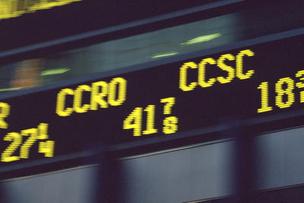A Scion Society of The Baker Street Irregulars
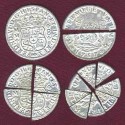
The Highly Irregular Shilling
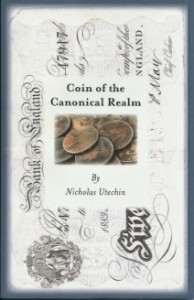 In the John H. Watson Society’s first monograph, Coin of the Canonical Realm, Nicholas Utechin has provided us with a fascinating look at the relative values of current-day dollars and pounds compared to the pounds and shillings of Holmes’s day. Of course, any devotee of the Canon is familiar with shillings, the coins with which Holmes paid his Irregulars (and which the Baker Street Irregulars still present to new members). There were twenty shillings in a pound, and twelve pence in a shilling for hundreds of years, until the UK went to decimal coinage in 1971.
In the John H. Watson Society’s first monograph, Coin of the Canonical Realm, Nicholas Utechin has provided us with a fascinating look at the relative values of current-day dollars and pounds compared to the pounds and shillings of Holmes’s day. Of course, any devotee of the Canon is familiar with shillings, the coins with which Holmes paid his Irregulars (and which the Baker Street Irregulars still present to new members). There were twenty shillings in a pound, and twelve pence in a shilling for hundreds of years, until the UK went to decimal coinage in 1971.
Few people know that the United States had shillings, too, which were in common usage from the 1790s until the eve of the Civil War. Unlike the British shilling, the American shillings were not coins, but units of accounting, which were traditionally used to keep track of sales, store accounts and the like, and even issued as bank scrip for trade.
To make the situation truly confusing, there was not one single American shilling, but four, which were used in different parts of the country. Each had a different value, none of which was equal to the value of a British or Canadian shilling in US currency. Those values varied according to the exchange rate of the day; in 1839, for instance, a Canadian shilling was worth 20 cents US, and when the British pound equaled $5.00 US (as it did in 1840), an English shilling was worth 25 cents.
The “New England shilling,” which was used in New England, Virginia, Kentucky and Tennessee, was valued at six to the dollar … making it worth a not very user-friendly 16 2/3 cents. The “Pennsylvania shilling,” used there and in New Jersey, Delaware and Maryland, was worth 13 1/3 cents, and the “Georgia shilling,” utilized in that state and South Carolina, equaled 21 ½ cents.
The poor math students of the day not only had exercises converting these shillings to and from dollars, but from one to the other!
At this point, I should mention another difference between American and English shillings: English shillings consisted of 12 pence, or pennies. American shillings consisted of so many cents. And even though Americans use the terms penny and cent interchangeably – and kept their accounts in shillings and pence — they’re not the same. A cent is one one-hundredth of a dollar, but prior to the introduction of the decimal pound a penny was one two-hundred-fortieth of a pound. Just as an American shilling was not worth as much as a British shilling, an American cent was not worth as much as a British penny; at $5.00 to the pound, a penny equaled approximately 2.1 cents.
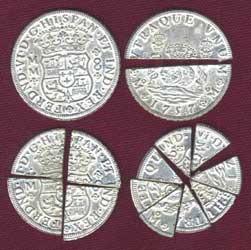 To return to American shillings, there was one last version, the “New York shilling” used in New York and North Carolina. Of the four US shillings, the New York version was the easiest to use. The NY shilling was valued at 12 ½ cents. This meant that it was worth half a U.S. quarter, one eighth of a dollar, and, perhaps most significantly, one eighth of a Spanish milled dollar. These Spanish silver dollars were in common circulation in the US, and were often cut into segments for use as change … into halves, quarters and eighths, thereby giving the coins their popular name, pieces of eight. These eighths were known as bits … which is why we call a quarter “two bits.”
To return to American shillings, there was one last version, the “New York shilling” used in New York and North Carolina. Of the four US shillings, the New York version was the easiest to use. The NY shilling was valued at 12 ½ cents. This meant that it was worth half a U.S. quarter, one eighth of a dollar, and, perhaps most significantly, one eighth of a Spanish milled dollar. These Spanish silver dollars were in common circulation in the US, and were often cut into segments for use as change … into halves, quarters and eighths, thereby giving the coins their popular name, pieces of eight. These eighths were known as bits … which is why we call a quarter “two bits.”
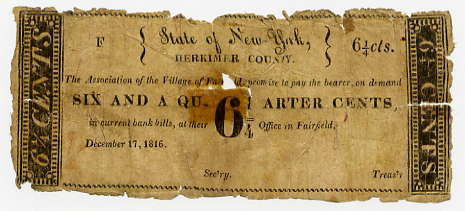 Through the 1840s, people in New York used bit coins and banknotes issued in denominations of 12 ½ cents and even 6 ¼ cents, and some traditionalists continued keeping their accounts in shillings into the 1860s. Incredibly, the last vestige of the New York shilling remained in use until 1997, when the New York Stock Exchange stopped reporting stock prices in dollars and eighths.
Through the 1840s, people in New York used bit coins and banknotes issued in denominations of 12 ½ cents and even 6 ¼ cents, and some traditionalists continued keeping their accounts in shillings into the 1860s. Incredibly, the last vestige of the New York shilling remained in use until 1997, when the New York Stock Exchange stopped reporting stock prices in dollars and eighths.
English shillings and American shillings, pennies and cents … a bit of American trivia from the decades pre-dating Nicholas Utechin’s fine overview of the coins of the Canon.
Note: This paper is based upon research done while the author was Curator of History at Old Bethpage Village Restoration, a re-created mid-nineteenth century village on Long Island, New York. Virtually every elementary math textbook used in America during the first half of the nineteenth century would have had a section on shillings.
Following up on a long standing interest in Sherlock Holmes, Harrison “Terry” Hunt, the 31st Garrideb, became an active Sherlockian after the Baker Street Irregulars 75th anniversary excursion to The Knothole, Christopher Morley’s writing retreat, in 2009. Since then, he has been an active member in many scions in the Northeast including The Three Garridebs; Sons of the Copper Beeches; Mrs. Hudson’s Cliffdwellers; Montague Street Lodgers; Sherlock Holmes Society of London; The John H. Watson Society; The Beacon Society and the Epilogues of Sherlock Holmes and have had articles published in the Baker Street Journal, The Watsonian and Prescott’s Press. Most recently, Hunt is the cofounder (along with this wife, Linda) & Commissar of the Grillparzer Club of the Hoboken Free State, a scion group celebrating Christopher Morley.
A version of this paper was given at the March 16, 2013 meeting of The Three Garridebs of Westchester County, NY, and was also published in Vol. 2, No. 1 of The Watsonian. This article is copyrighted ©2014 by the author.

